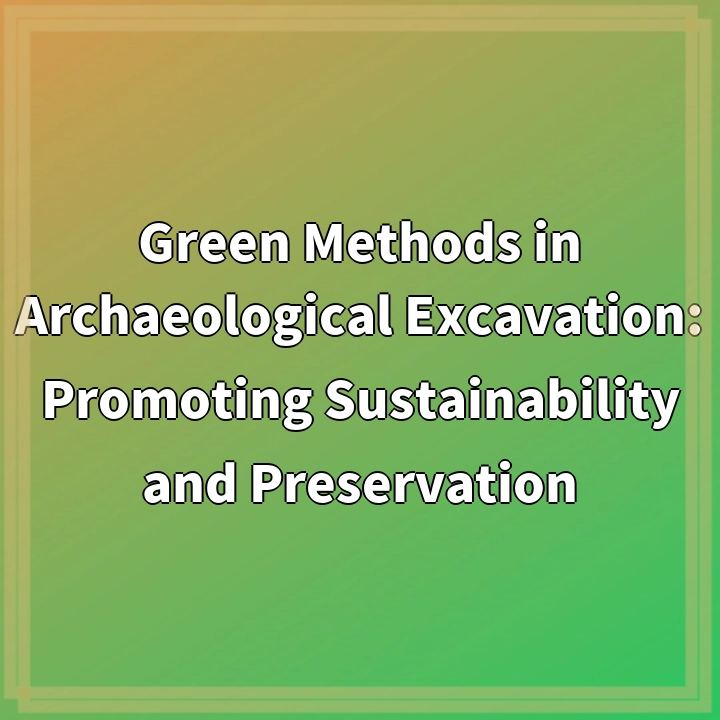
What it is:
Green methods in archaeological excavation refer to the adoption of sustainable and environmentally friendly practices during the process of uncovering and studying ancient artifacts and structures. These methods aim to minimize the negative impact of archaeological activities on the natural environment while promoting the long-term preservation of cultural heritage.
Real-World Problems:
1. Site Degradation: Traditional excavation techniques can cause significant damage to archaeological sites, such as erosion, compaction of soil, and disturbance of fragile structures. These processes can result in the loss of valuable cultural and environmental information.
2. Environmental Footprint: The use of heavy machinery, excessive excavation, and inadequate waste management can lead to increased carbon emissions and ecosystem disruption. Archaeological excavations often require the clearing of vegetation, which can disrupt local ecosystems and contribute to deforestation.
3. Resource Intensiveness: Traditional methods of excavation may require large amounts of resources, including water and energy. This consumption can contribute to the depletion of natural resources and further strain already limited supplies in archaeological sites located in remote or arid areas.
4. Artifact Preservation: Improper handling, storage, and transportation of artifacts can lead to their deterioration and loss. Inadequate climate control and exposure to fluctuating environmental conditions can cause irreversible damage to archaeological finds.
5. Lack of Community Engagement: Archaeological projects that do not involve or consider local communities can fail to address their needs and concerns. This can lead to social conflicts, lack of support, and even destruction or looting of archaeological sites.
6. Ethical Considerations: The desire to unearth new discoveries can sometimes prioritize excavation speed over thorough documentation and analysis, compromising the accuracy and completeness of archaeological records. Additionally, the repatriation of cultural artifacts to their country of origin is a significant ethical issue that needs to be addressed.
By utilizing green methods in archaeological excavation, these real-world problems can be mitigated, contributing to a more sustainable and responsible approach to exploring and preserving our archaeological heritage.

Solutions for Green Methods in Archaeological Excavation:
Implementing sustainable practices in archaeological excavation can address the real-world problems outlined above and promote a more environmentally friendly and socially responsible approach to studying cultural heritage. Here are some solutions:
1. Site Protection and Management:
– Implement proper site monitoring and documentation to minimize site degradation.
– Use non-invasive or low-impact techniques, such as remote sensing and geophysical surveys, to gather information without extensive excavation.
– Establish guidelines and regulations for site conservation and sustainable land management.
2. Sustainable Excavation Techniques:
– Utilize manual excavation methods or lightweight equipment to minimize damage to structures and artifacts.
– Opt for careful stratigraphic excavation to preserve the contextual information of archaeological finds.
– Implement controlled soil removal and backfilling techniques to reduce erosion and compaction.
3. Resource Efficiency:
– Conserve water by incorporating techniques like wet sieving and closed-loop water systems.
– Optimize energy usage by utilizing renewable energy sources and minimizing the use of machinery.
– Employ sustainable waste management practices, such as recycling and proper disposal of hazardous materials.
4. Artifact Preservation:
– Develop comprehensive artifact conservation plans, including proper cleaning, stabilization, and storage techniques.
– Create controlled storage environments with the necessary climate control measures to protect artifacts from deterioration.
– Train staff in proper handling and storage procedures to ensure the longevity of archaeological finds.
5. Community Engagement:
– Involve local communities in the decision-making processes and actively engage them in archaeological projects.
– Raise awareness about the value of cultural heritage and its significance to local communities through outreach programs and educational initiatives.
– Provide opportunities for community members to actively participate in excavation activities and learn about their heritage.
6. Ethical Considerations:
– Prioritize meticulous documentation and analysis to ensure accurate and comprehensive archaeological records.
– Promote international collaboration and respect for repatriation policies to address the ethical concerns relating to the ownership and display of cultural artifacts.
– Encourage ethical research practices that prioritize the well-being and interests of local communities, respecting their cultural beliefs and traditions.
By implementing these solutions, archaeologists and heritage professionals can contribute to sustainable archaeological excavation practices that protect the environment, preserve cultural heritage, engage local communities, and uphold ethical standards in the field.















